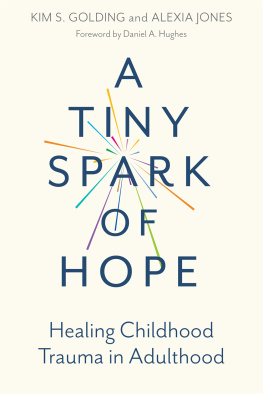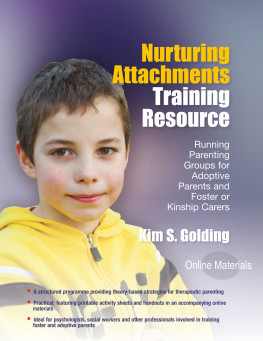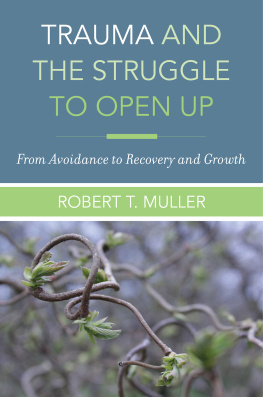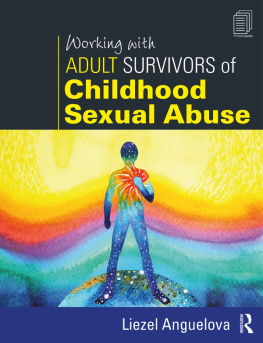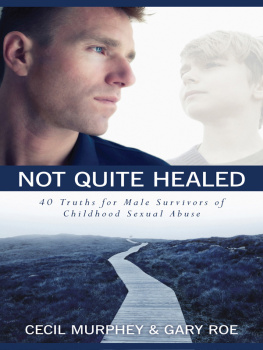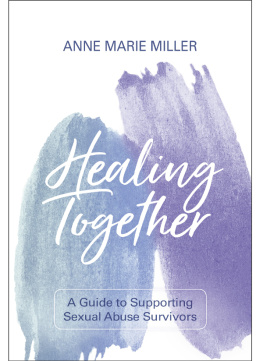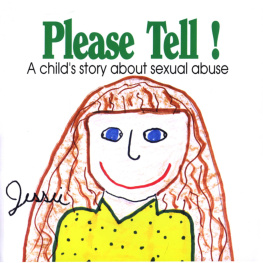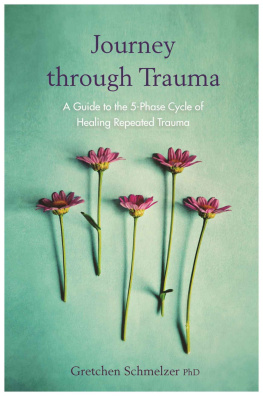Contents

A
TINY
SPARK
OF
HOPE
Healing Childhood
Trauma in Adulthood
KIM S. GOLDING and AL EXIA JONES
FOREWORD BY DANIEL A. HUGHES

Contents
FOREWORD
Family relationships are so important for children. These are their first relationships and will affect the childrens psychological and physical development. Children develop a bond with their parents which helps them to emotionally connect to them. These are called affective bonds, because the children experience them emotionally. Each bond a child forms is unique. While these are one of a kind, there are features of them which are common for all children. These features are crucial for the well-being of the child.
To develop well, children need a relationship with a parent or parents that is available from birth. These relationships provide the infants with an experience of being responded to that is contingent. This means that the parents response is influenced by what the child is doing or signalling; if the infant cries, a contingent response is to soothe. These are reciprocal relationships, with each influencing the other: an infant cries and the parent soothes, the infant calms and the parent feeds, and so on. As you can see from this example, with very young children this is non-verbal and body based. The parent is attuned to what is going on in the infant and what is being communicated non-verbally. In the example above the parent might notice that the infant is trying to suckle on his finger whilst his crying is communicating his distress. The parent is continuously fine-tuning her own response in response to what the infant is doing. The parent is synchronised to the state and actions of t he infant.
These ongoing, open and engaged interactions with a loving parent help the child to develop trust in human relationships. As the infant matures, these relationships provide the child with the experiences needed to develop his capacity to regulate his affective states. This means that when he becomes emotionally aroused, he can calm and soothe himself. A younger child needs help to do this (co-regulation), but with maturity he will gradually be able to self-regulate. Alongside this the child is learning to reflect. As his language develops, he learns to think and talk about what he is experiencing and to notice what others might be experiencing. The inner life of thoughts, feelings and wishes become understood and com municated.
You will notice that developing the ability to communicate in words is an important part of a childs early development. Childrens words develop within the relationships that they are experiencing. This gives the children the ability to explore the past and think about the future. The children learn to form stories. These are stories of their life that allow the children to develop a coherent narrative about their experience. Psychologists believe that having an ability to form stories that make sense (are coherent) is good for emotional w ell-being.
In this book you will meet Alexia, who did not get the healthy relationship experiences that I have been describing. She experienced relational trauma. The traumatic experiences that she encountered came from within her family relationships. Relational trauma distorts, weakens or even puts a stop to the dynamic, relational, developmental process we have explored in a healthy infant and child. This trauma leads to the child developing mistrust in human relationships. The child does not have the experience needed to develop healthy capacity to regulate her affective states or to make sense of her internal experience, such as her thoughts, feelings and wishes. She also cannot make sense of other members of her family and what their internal experience might be. This makes it difficult for children to understand the meaning of the events that are occurring in their home. The stories that they develop tend to be fragmented, incomplete and embedded in feelings of shame and fear. The child does not feel good enough or deserving of love and care and is fearful of what is going to happen next. During the reading of this book you will see how some of these consequences of relational trauma had an impact on Alexias psychological de velopment.
In this book you will be introduced to a therapist, Kim, who helped Alexia, now an adult, using a model of therapy called dyadic developmental psychotherapy (DDP). I developed the therapy to help children who had experienced relational trauma, reducing its impact and helping the children to engage in healthy relationships. This then gives the children what they need for healthy development. It is a family model of therapy, actively involving the childrens caregivers so that they are more able to meet their childrens comprehensive needs. The core interventions of DDP are based on principles arising from our knowledge of the synchronised, relational processes just described in the context of the theories and research of attachment, intersubjectivity and trauma. These are theories about relationships and what happens when children are traumatised within these rela tionships.
However, relationship trauma does not only hurt the child during childhood. Its impact is likely to continue into adulthood. Long after the trauma stops, the child-now-adult is still likely to have difficulty with relating, regulating and reflecting. As adults, they still may have difficulty consistently engaging in the synchronised, reciprocal interactions which they lacked experience of during their early childhood. These adults still carry much fear and shame within themselves. At times, their emotions seem separate from their sense of self and erupt independently from the wishes of the self. Or their emotions remain silent and frozen when they are needed to give expression to the self. And their thoughts are too often confused and doubtful, losing the plot regarding issues that are important to the self.
This book presents how Kim engages in DDP with Alexia. Those familiar with DDP as it is used with children will see that the same characteristics of DDP used with children (PACE, intersubjectivity, co-regulation of affect, co-creation of meaning, followleadfollow, and developing a therapeutic conversation through affective-reflective dialogue) are also very valuable in the therapy of an adult who continues to be challenged by the traumas of childhood.
It is not surprising that Kim utilises DDP as an effective intervention with Alexia, since core relational, regulatory and reflective skills in adulthood continue to involve the same characteristics of relating that were crucial for development in childhood. The voices of both the therapist and client are presented in the following pages as they each express how both were affected by the course of the therapy. The nature of DDP is evident in their descriptions of how they were each touched by the experiential nature of the therapeutic process. The way that they both experienced the relationship with each other helped Alexia to heal from the impact of her early traumatic e xperience.
DDP focuses on the co-regulation of affective states associated with stressful events or trauma that may be challenging to the client. The client can think about her experience without becoming overwhelmed by the emotion of this reflection because of the regulating presence of the therapist. While these states remain regulated, DDP can then focus on co-creating new meanings of the traumatic event, whilst at the same time facilitating the clients reflective functioning. For example, a client might come to understand that they were not abused because they deserved it and therefore start to think about themselves differently. Since generally the adults reflective skills surpass those of the child or young adolescent, the adult may well be able to utilise DDP to develop new meanings of traumatic events to a greater extent than a child. Alexia demonstrates such reflective skills as she successfully addresses the past and present challenges of her life.

